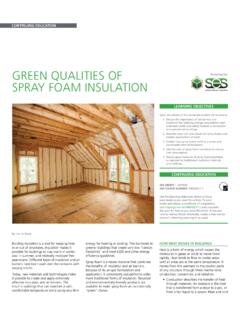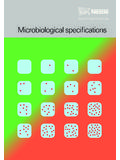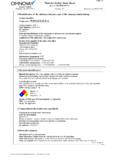Transcription of UNDERSTANDING HAZARD, EXPOSURE, AND RISK …
1 CONTINUING EDUCATIONE very day, architects, builders, and other building professionals specify and use products that help them create appealing, durable, and functional homes, offices, schools, hospitals and other structures. Innovations in chemistry contribute greatly to developing building materials that help meet today s evolving needs. For example, high performance spray foam insulation helps improve buildings energy efficiency; synthetic flooring in hospitals and operating rooms can be easily cleaned and disinfected; and plastic coatings added to metal roofing can protect the roof for years from corrosion and the physical impacts of storms and the elements. While these innovations have tremendous benefits, there is increased interest around how building materials may affect the health of building occupants and the environment. Architects and other building professionals want to understand health and safety information about product ingredients and be able to make informed choices about the materials they select.
2 Balancing important factors like performance, durability, and aesthetics with health, safety, and environmental impacts can be a challenge. But an informed material selection process can help advance the health, safety and welfare of building occupants without sacrificing the quality and effectiveness of the building materials article will review basic concepts that could change how you look at materials and your materials specification processes. It begins with UNDERSTANDING the differences between hazard, exposure and risk or danger the importance of considering product use and exposure and the limitations of using a hazard-only decision making process when selecting building materials. This article also will describe some tools, guidance and resources available for evaluating products and materials to help LEARNING OBJECTIVESUpon completion of this course the student will be able to:1. Understand the difference between hazard, exposure, and risk and their uses to inform material and product Describe the limitations of hazard-only assessment when selecting building materials and the benefits of including other factors beyond hazard in product decision Identify appropriate tools and guidance materials for evaluating building products and materials to enhance the health, safety and welfare of the Identify resources available that can help you evaluate exposure levels to ingredients in buildings products and EDUCATIONAIA CREDIT: 1 LU/HSW AIA COURSE NUMBER: Use the learning objectives above to focus your study as you read this article.
3 To earn credit and obtain a certificate of completion, visit and complete the quiz for free as you read this article. If you are new to Hanley Wood University, create a free learner account; returning users log in as HAZARD, EXPOSURE, AND RISK IN THE BUILT ENVIRONMENTP resented by:By Andrew HuntCONTINUING EDUCATION achieve both a high quality construction project, and one that is safe for building occupants. Finally, this article will provide information to help you use building materials 1 CONSIDERING HAZARD, EXPOSURE AND RISK WHEN SELECTING BUILDING MATERIALSM aterial selection is a critical aspect of the building design and construction process. The materials that comprise a building not only affect how the building looks and performs, but also can have an impact on the health, safety, and welfare of the people in the building. Increasingly, architects and builders seek to specify and provide clients with innovative materials that not only perform well, but also reduce the amount of resources consumed and improve overall health and environmental the appropriate building materials can be a straightforward task with the proper information.
4 But what information should building professionals consider before making a selection decision?Defining hazard, exposure, and riskWhen selecting a material or product for a building project, the core issue comes down to UNDERSTANDING the difference between hazard and exposure, and the relationship of both when it comes to informing risk or danger. So what goes into the determination that a material or product might cause or result in a negative impact on human health or the environment? An easy way to think of the relationship is that a hazard is anything that might cause harm to a person because of some characteristic it has. Exposure, or contact, relates to the amount of or frequency with which a person comes in contact with the hazard. Think of exposure as hazard in context with use or another form of contact. Risk is the possibility of harm that may come from exposure to a hazard. Danger is a commonly used term to indicate risk.
5 Alone, a hazard does not present a risk/danger unless there is contact, a level of exposure. To put it in terms of a simple equation: Hazard x Exposure = RiskAn example that illustrates this concept is exposure to sunshine, specifically the sun s ultraviolet rays. In temperate climates, ten minutes of direct sun exposure without sunscreen will likely not harm a person, and can be beneficial by providing a natural dose of Vitamin D. However, longer time spent in the sun 30 minutes, an hour or longer, might result in painful sunburn, and the risk of the negative effect the sunburn increases as the exposure time increases. Risk can also increase if the exposure is more concentrated ten minutes of exposure in a very hot climate at the peak of summer may result in sunburn, and longer exposure will increase the risk. To take this a step further, repeated or severe unprotected sun exposure may lead to skin cancer. We can look at chemical ingredients in building materials in a similar fashion: Hazard refers to the inherent properties of a chemical substance that makes it capable of causing harm to a person or the environment.
6 Exposure describes the amount, duration, and frequency with which a chemical substance comes into contact with a person, group of people, or the environment. Risk, or Danger, then, is the possibility of harm arising from a particular exposure to a chemical substance, under specific conditions. Evaluating hazardsIn this article, we will consider two main types of hazards: human health and environmental. If direct human contact is anticipated, then questions related to human health hazards also called the human health endpoints are important. If direct human contact does not occur but the product or material is expected to be used or discarded in a way that impacts water, soil, outside air, or wildlife, then environmental hazards are key. Table 1, below, provides a starting point for considering which hazards are relatively more classify hazards based upon test results that address exposure to the chemical in its pure form.
7 Some tests are designed to indicate chronic toxicity (longer term or recurring repeat exposure) or acute toxicity (a single or short term exposure). Generally, most chemical manufacturers are required to use the World Health Organization s Globally Harmonized System of Classification and Labeling (GHS), which provides a global framework for hazard testing, classification, and labeling. In compliance with GHS, manufacturers provide a Safety Data Sheet that identifies chemicals having a hazard classification. Most other declarations use a format similar to GHS to identify the chemical Table 1: Considering Human Health and Environmental HazardsHazard EndpointsHuman HealthEnvironmentalChronic Effects: Cancer, Mutagenicity, Reproductive Toxicity (CMR), Target Organ Systemic Toxicity Acute Effects: Skin, eye, or respiratory irritation, or sensitization Chronic or acute aquatic toxicity Persistence or Bioaccumulation CONTINUING EDUCATIONone of the most widely used plastics and deemed safe for a variety of food contact applications, such as coffee cups, plates and take-out containers.
8 In this case, the chemicals used early in the production process are transformed into inert or benign molecules in the finished summarize, hazard assessment tools can provide useful information when used in conjunction with other information. But used alone, hazard may lead to poor product and materials selection decisions. Hazard needs to be put into the context of the product, how it is used and by whom. Building on hazard to incorporate exposureWith the increased availability of materials disclosure information, decision makers have access to information about the ingredients and their hazard classification in building products and materials. Hazard information is important if it is likely that an ingredient in a building product or material could have exposure, Limitations of hazard-only materials selectionChemical hazard-based lists, often known as red lists, are sometimes used to identify chemicals for reduction, phase out, or elimination.
9 When such lists are developed with scientific rigor and assignment of risk based on a substance s use in a specific application they can be a useful part of a risk-based chemical management program. However, red lists are often developed based on an evaluation of a chemical or substance hazard, without consideration of exposure to the chemical ingredient or how and why the ingredient is used in the product. Moreover, some hazard scoring tools include production chemicals that have been used at some point during a product s manufacturing process but are not present in the final building product or material. For example, the chemical benzene, classified a human carcinogen, is used in the synthesis of styrene to make polystyrene, (either specifically by scientific or by trade name) and its hazard class. Although hazard classifications are determined based on an evaluation of the pure chemical, building materials and products may contain smaller levels of multiple chemicals that together make up the final product used in the building.
10 Thus, the hazard of the pure chemical as classified may not apply to either the form or the level of the chemical present in the building product or material. As an example, titanium dioxide in dust form is classified as an inhalation hazard, but when titanium dioxide is in wet form, as in paint, there is no inhalation hazard. In another example, formaldehyde in the concentrated gaseous form is an inhalation hazard, but at lower concentration levels, like that found in human breath, it is not. For these reasons, determining the form and the exposure level of an ingredient are important factors when determining danger or risk. CONTINUING , human contact. Unfortunately, current disclosure forms often do not contain critical exposure information. A useful framework might ask: What is the product? Where is it used in the building? Is human contact expected during expected use? If so, what degree of contact is expected? For example, if the product or material is within the building envelope and direct contact with the building occupant is not anticipated, one might evaluate the material differently than if building occupants are in contact with the material on a daily basis.












